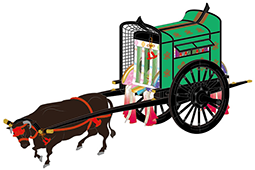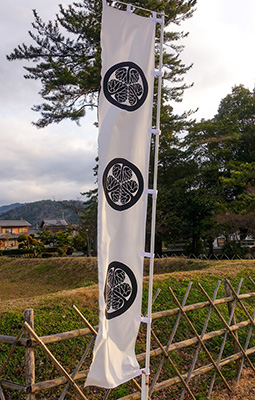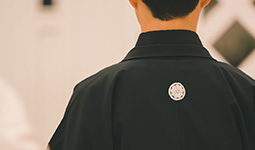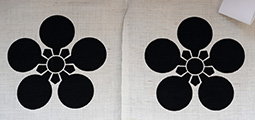December 2022
- English
- 日本語
Kamon, Japanese Family Crests, Their History and Features

A roof tile with the imprint of a family crest (5-7 paulownia) 
Paulownia blossoms

Ox cart illustration 
Reproduction of a banner featuring the Tokugawa shogunate’s familiar “triple hollyhock” crest 
A family crest printed on a kimono 
A family crest (plum blossom) printed on the noren entrance curtain to a building

Most Japanese families have a family crest that has been passed down from generation to generation. Japanese family crests, or kamon, have distinctive features, an abundance of motifs, and are skillfully designed.

Japanese people have long used their family crest on kimonos for ceremonial occasions and on their tombstones. Known as kamon, these family crests feature motifs such as plants, animals and the stars that have been familiar to Japanese people since ancient times. If the designs are carefully categorized, it is said that there are more than 30,000 such crests.
The family crest originated in the latter part of the Heian period (late 8th to end 12th century) when dynastic culture flourished in Japan. At that time, aristocrats attached their original patterns to their ox-drawn carriages so that anyone could tell who the cart belonged to at a glance.
Takasawa Hitoshi, president of the Japan Family Crest Research Society, explains, “I believe that the most important reason why aristocrats at that time put their unique patterns on their ox-drawn carriages was because of etiquette on the road. For example, if you are riding in an ox-drawn carriage and pass by the ox-drawn carriage of someone of higher status, then you must get off and give way, or even prostrate yourself before them, depending on their status. This etiquette displayed on the road was later called rotorei and was becoming increasingly emphasized in the aristocratic society of the day when family crests appeared.”

The aristocrats of the Heian period, who led lavish lifestyles, competed with each to have the most elegant and auspicious patterns on their ox-drawn carriages. However, the original purpose was to express status, ancestry and class through the use of patterns. Eventually, these patterns developed into family crests that simply represented one’s family or clan.
In the Kamakura period (late 12th century to 1333), with the dawn of the samurai era, samurai families began to use family crests to distinguish between friend and foe on the battlefield and to show off their clan’s military achievements. Each crest is associated with a desire for a boost in the warrior’s fortune in battle or prosperity for one’s descendants. These family crests were often displayed prominently on armor, as well as on the camp enclosures and flags hoisted on the battlefield, so that the warriors’ allegiance could easily be identified.
Takasawa explains, “Originally, unlike the crests of aristocratic families, the crests of samurai families, which were used to distinguish between friend and foe on the battlefield, were generally designed with simple single motifs. The motif had to be simple yet impressive and skillfully designed, easily recognizable from a distance.

When the war-torn era ended and the Edo period began (early 17th to mid-late 19th century), townspeople also started using family crests. At that time, many commoners were prohibited from using surnames, but since having a family crest was not prohibited, the crest was often used to identify a family at a glance in place of a surname. In 1868, the Tokugawa shogunate returned political power to the Emperor, the Edo period ended, and Japan’s modernization began. In 1875, a decree promulgated by the new government required all citizens to have surnames, which in principle had been limited to noble and samurai families. When people started picking their new family names and designed patterns to their own liking, it seems many took the opportunity to use family crests that were consistent with their origins, and those who did not previously have a surname set their family crests on the advice of local masters. Moreover, when establishing a new branch family, there were many people who used slightly different crests, such as surrounding the main family’s crest with a circle, so the number of family crest types increased.


For example, the “paulownia crests” with their paulownia tree motif are familiar as a typical example of Japanese family crests, and they vary widely in the way the leaves are drawn and the number of petals. For example, designs where the number of flowers is arranged in the order of five, three, and five are called “5-3 paulownia,” while those arranged in the order of five, seven, and five are called “5-7 paulownias.”
It can be said that the most notable features of Japanese family crests are the abundance of their motifs and their skillful design.



